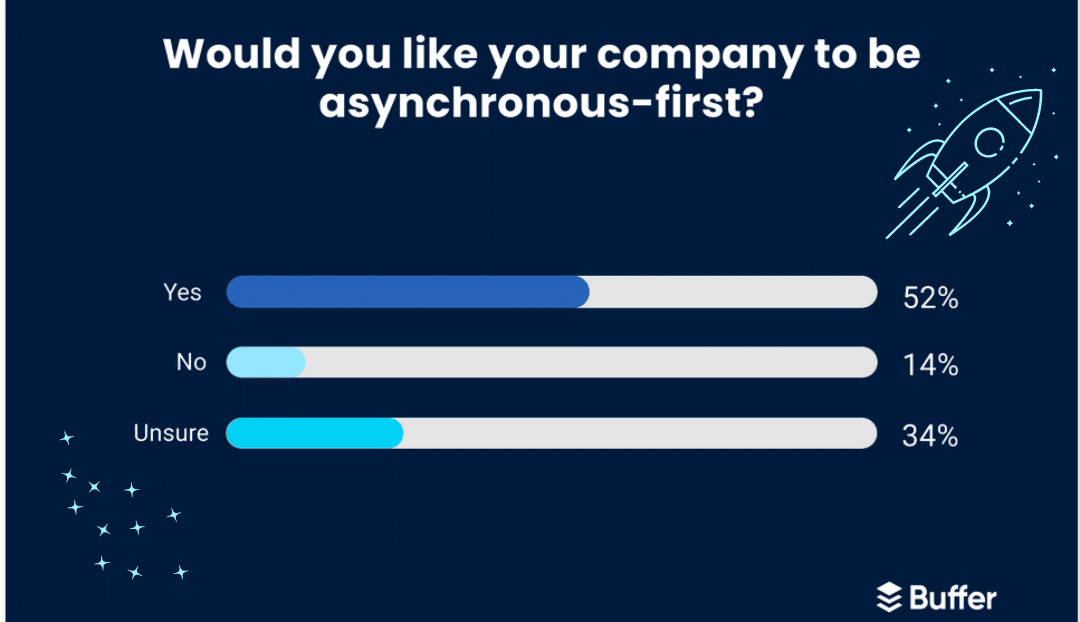written by Sina Brust
Mastering asynchronous (async) communication is essential for remote and hybrid teams to keep up with the fast-changing dynamics of modern work environments. We put together useful tips and insights to help you communicate effectively in digital-first workplaces. 🚀
This blog article sums up the main points from a LinkedIn Live talk on async communication with Mark Cruth (Modern Work Coach) and Barbara Covarrubias Venegas (Founder of #virtualspacehero).

Mark is a pragmatic modern work designer and coach with over a decade of experience at companies like Boeing, Nordstrom, TD Ameritrade, and Rocket Mortgage.
Focusing on practice over theory, he aims to transform teamwork practices with modern methods, a transformation mindset, and expert storytelling.
He is also an expert in async communication and shares his insights on global events.
Understanding Async Communication 🤔
Async communication is the art of exchanging information without expecting an immediate response.
Async communication, or asynchronous communication, is a method of exchanging information where responses are not expected immediately. Unlike synchronous communication, which happens in real-time through phone calls, video conferences, or in-person meetings, async communication allows team members to respond at their convenience. This flexibility is especially beneficial in remote and hybrid work environments, where team members might be spread across different time zones and working schedules.
One of the key advantages of async communication is that it supports a more flexible and balanced work-life integration. Team members are not required to be online simultaneously, which reduces the stress associated with constant availability and allows them to work during their most productive hours. This flexibility can lead to increased overall productivity and better focus on tasks, as employees can manage their time more effectively without the interruptions common in synchronous communication.
Moreover, async communication builds an environment of thoughtful and considered responses. Team members have the time to think through their replies, leading to more deliberate and high-quality contributions. This can enhance the decision-making process, as ideas and feedback are well-formed and not rushed by the pressure of immediate response requirements.
In addition to supporting individual productivity and focus, async communication also enhances team collaboration. It allows for better documentation and tracking of conversations, as all communications are written and can be referenced later. This is particularly useful for keeping a record of decisions, brainstorming sessions, and project updates. Having a documented trail of communication helps in maintaining continuity, especially when onboarding new team members or when team members need to revisit past discussions.
Challenges in Async Communication 🚧
A common challenge in async communication is the potential for misunderstandings due to the lack of immediate feedback. Since the communication is not happening in real-time, it’s crucial that the messages are clear, detailed, and easy to understand to avoid misinterpretations. This requires excellent writing skills, as the sender must anticipate potential questions and provide comprehensive information upfront.
Why is it important to work on that? According to the last Buffer State of Remote Work Report, 52% want their company to be asynchronous-first.

Strategic Solutions to Overcome Challenges
To prevent misunderstandings, intentional communication is critical—being clear, concise, and purposeful with every message sent. Setting clear guidelines and expectations for communication helps reduce misunderstandings and improve workflows.
Excellent writing skills are crucial for creating high-performing teams, regardless of their remote, in-person, or hybrid work environment.
Here’s an overview of the benefits:
- Enhances Clarity and Precision: Effective writing reduces misunderstandings by ensuring clear and precise communication.
- Boosts Efficiency: Clear communication streamlines workflows, saving time and accelerating project progress.
- Promotes Professionalism: Well-crafted messages enhance a team’s professional image internally and externally, boosting credibility.
- Facilitates Robust Documentation: Strong writing skills ensure that documents are coherent and organised, supporting project continuity and knowledge transfer.
- Improves Engagement and Collaboration: Quality writing keeps all team members engaged, promoting a culture of collaboration and inclusivity.
- Supports Scalability: Good writing is essential as teams expand, helping new members understand processes and expectations clearly.
- Aids in Conflict Resolution: Clear writing prevents conflicts by reducing miscommunications and helps resolve issues when they arise.
- Ensures Adaptability Across Communication Channels: Proficiency in writing ensures effective communication across various platforms and tools.
Investing in writing skills is foundational for team success:
It not only supports flexibility and productivity but also ensures that communication is clear, precise, and documented. As organizations continue to embrace digital-first workplaces, the ability to communicate effectively through async methods will become increasingly important, enhancing both individual performance and overall team collaboration.
However, organizations often overlook training for excellent writing skills, which can be a significant barrier.
How Atlassian Implements Async Communication🛠️
Atlassian, known for its productivity tools, including Confluence, Slack, and Trello, is a model for effective async communication strategies. These tools facilitate organized and efficient team communication, allowing for documentation and tracking of discussions and decisions. For example, using a Trello board for brainstorming ideas asynchronously can save time compared to in-person sessions.
At #VirtualSpaceHero we successfully work with tools like Trello and Slack for better async communication and organisation in our digital workplace. If you want to level up collaboration in your remote team and learn more, what are you waiting for?
Actionable Tips to Enhance Your Async Communication Skills
Here are several actionable tips to improve your async communication:
✅ Be intentional: Ensure every piece of communication has a clear purpose and actionable items.
✅ Set Clear Objectives: Reduce ambiguity by making sure each message or document has a distinct purpose.
✅ Optimize Tool Usage: Use the right tools for different communication needs. For example, use Slack for quick updates and Confluence for detailed knowledge sharing. Explore advanced features to enhance workflows.
✅ Enhance Message Clarity: Refine your messages by using bullet points or numbered lists. Avoid complex language or jargon.
✅ Consistent Updates: Keep your team updated regularly to build a shared understanding of project statuses and reduce isolation.
✅ Encourage Feedback: Create an environment where feedback on communication practices is encouraged to identify and address areas for improvement.
✅ Document Everything: Maintain comprehensive records of decisions and discussions to ensure continuity and provide reference points for new team members.
By implementing these strategies, you can significantly improve your async communication skills, leading to more effective collaboration and productivity in remote and hybrid work environments.
🌟 Conclusion
Mastering asynchronous communication and writing skills is a requirement for modern workplaces and even more important for effective team collaboration in any setting.
Whether teams are remote, in-person, or hybrid, the ability to communicate clearly and efficiently through written messages ensures that operations run smoothly, goals are met with precision, and team cohesion is strengthened. Investing in these skills enhances individual performance and elevates the entire team’s capability to succeed in a fast-paced, ever-evolving work environment.
As organisations adapt to new ways of working, prioritising asynchronous communication and writing excellence will undoubtedly be a key differentiator in achieving sustained high performance and organizational success.




